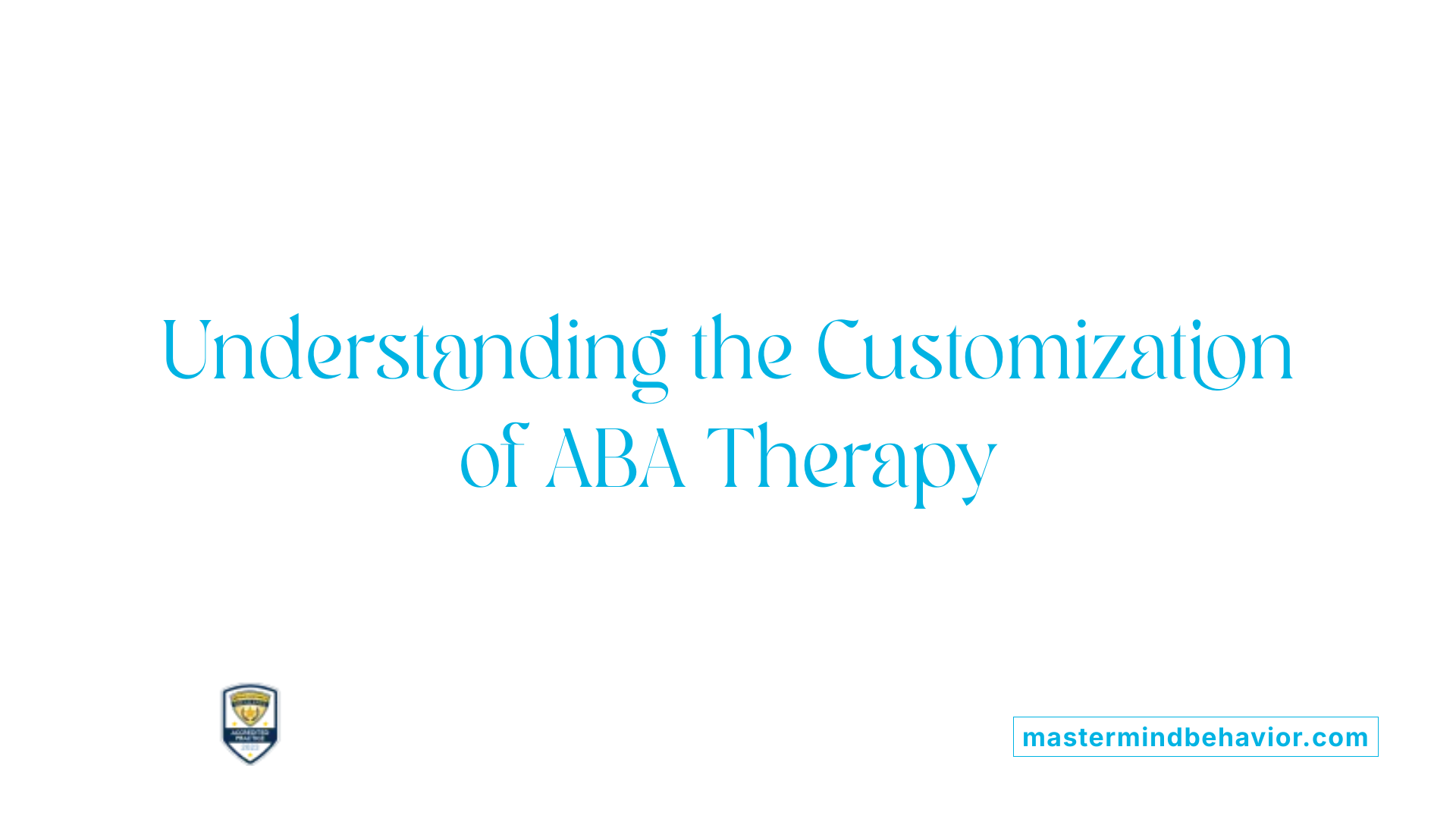How ABA Therapy Can Be Tailored to Each Child's Unique Needs

Understanding the Art of Tailoring ABA Therapy
Applied Behavior Analysis (ABA) therapy is renowned for its adaptability and effectiveness in addressing the unique needs of children with Autism Spectrum Disorder (ASD). Unlike many therapeutic approaches, ABA is designed to be highly individualized, offering a flexible framework that can be custom-fit to each child's specific strengths, interests, and developmental challenges. This article explores the core concepts of ABA therapy customization, detailing the processes and methodologies that make this approach uniquely beneficial.
The Fundamentals of ABA Therapy Customization

What makes ABA therapy unique?
ABA therapy, or Applied Behavior Analysis therapy, stands out due to its evidence-based framework that prioritizes behavior modification. This is accomplished through systematic observation and data collection, ensuring that every aspect of the therapy is measurable and relevant.
The essence of ABA is in its customization; each therapy plan is uniquely designed to meet the specific needs, strengths, and challenges of the individual child. Through detailed assessments, behavior analysts identify the child's unique developmental requirements, tailoring interventions for maximum effectiveness.
Individual Assessment Techniques
The initial assessment in ABA therapy is critical and involves analyzing a child's behaviors, skills, and preferences to create a customized treatment plan. The emphasis is on:
- Identifying Strengths and Weaknesses: Highlighting areas where the child excels and where they face challenges.
- Formulating Specific Goals: These goals should adhere to the SMART criteria, ensuring they are Specific, Measurable, Achievable, Relevant, and Time-bound.
- Ongoing Evaluation: Continuous data collection during sessions allows for monitoring progress and making necessary adjustments.
Core Principles of ABA
Central to ABA are its core principles, which involve understanding behavior in context and leveraging various teaching techniques, including:
- Discrete Trial Training (DTT): A structured method breaking down skills into simpler components for targeted teaching.
- Natural Environment Teaching (NET): Engaging children in their everyday environments to enhance learning applicability.
Role of Reinforcement in ABA
Positive reinforcement is vital in ABA therapy, serving to motivate and encourage children to display desired behaviors. This can include:
- Rewards for Progress: Using tangible rewards or verbal praise for achieving specific goals.
- Adaptability to Motivations: Tailoring the reinforcements based on each child's unique motivations and interests, enhancing engagement in therapy sessions.
In summary, the flexibility and individualized nature of ABA therapy not only support effective learning but also promote meaningful long-term results for children with autism.
Types of ABA Interventions and Their Customization

What are three different types of interventions based on the principles of ABA?
Three different types of interventions based on the principles of Applied Behavior Analysis (ABA) are:
Discrete Trial Training (DTT)
This method involves breaking down complex skills into smaller, manageable steps. Each skill is taught in a highly structured way with clear prompts, cues, and reinforcement to encourage correct responses. DTT provides children with clear expectations and consistent feedback, which helps solidify new learning.Pivotal Response Training (PRT)
PRT focuses on teaching pivotal behaviors—those that have a broad impact on other behaviors. This intervention encourages motivation and responsiveness by using natural reinforcers to foster engagement. The idea is that by stimulating milestone skills, children will start to develop a range of social and communication abilities.Natural Environment Teaching (NET)
NET integrates learning into natural settings. By teaching skills within real-life situations, children are better able to generalize what they've learned. This method promotes practical application, ensuring that children can use their skills effectively beyond the therapy sessions.
How different interventions are customized
ABA therapy is not a one-size-fits-all approach; it is meticulously customized to address the unique needs of each child.
Assessment-Based Customization
Each intervention starts with a detailed assessment conducted by a Board-Certified Behavior Analyst (BCBA). This assessment helps in identifying strengths, weaknesses, and specific challenges to create tailored treatment plans.Incorporating Learning Styles
Therapists adapt strategies based on each child’s preferred learning style. For instance, children who thrive on visual cues may see more success with DTT, whereas those who benefit from playful, engaging environments might respond better to PRT or NET.Family Involvement
Parent and caregiver involvement is crucial. Programs are often designed to include family dynamics and incorporate training parents to reinforce skills at home, making learning consistent and relevant.
Through this personalized approach, ABA therapy helps ensure that children achieve better long-term outcomes by adapting to their individual needs and circumstances.
Identifying the Need for ABA Therapy

How do you know if your child needs ABA therapy?
To determine if your child needs ABA therapy, it's essential to observe their development in several key areas, including communication, social skills, and adaptive behavior. Here are some signs that may indicate a need for ABA:
- Difficulties forming friendships: Struggling to make or maintain peer relationships.
- Challenges with social cues: Difficulty understanding body language, facial expressions, or taking turns in conversation.
- Delays in developmental milestones: Not reaching expected speech or social milestones for their age.
- Problem behaviors: Engaging in actions that interfere with learning or daily living, like tantrums or non-compliance.
If you notice these signs, assessing your child's specific needs becomes crucial. Parent and teacher observations, combined with professional evaluations, can provide important insights. Consulting with a qualified ABA therapist can clarify whether your child could benefit from structured support.
Role of assessments in ABA
Assessments play a pivotal role in ABA therapy, identifying individual strengths and challenges to customize an effective treatment plan. Initially, a board-certified behavior analyst (BCBA) conducts a thorough evaluation to determine specific areas of focus, which could include:
- Communication skills: Expressive and receptive language capabilities.
- Social Interaction: Engagement in peer relationships.
- Daily living skills: Self-care and adaptive functioning.
The insights gained from assessments enable therapists to set SMART goals tailored to each child's unique situation, informing all aspects of therapy. This tailored approach ensures that interventions are not only relevant but also maximally effective for promoting meaningful progress.
Exploring the Benefits of Tailored ABA Therapy

What are the needs and benefits of ABA therapy?
ABA therapy offers a multitude of benefits, particularly for children with Autism Spectrum Disorder (ASD).
This structured approach is individualized to meet each child's unique needs and goals. A comprehensive assessment by a Board-Certified Behavior Analyst (BCBA) guides the development of a treatment plan that targets specific skills such as communication, social skills, and self-care. Early intervention, particularly before age six, is vital to maximizing developmental outcomes.
By breaking down complex skills into manageable steps, therapists foster a learning environment that cultivates improvement. Techniques such as Discrete Trial Training (DTT) and Natural Environment Teaching (NET) are versatile, allowing therapists to adapt their strategies based on the child’s learning style and interests. The flexibility and customization of ABA therapy ensure not only engagement but also effective skill acquisition across various contexts.
Involving families in the therapy process enhances its effectiveness. Parents learn to reinforce positive behaviors at home, creating consistency and continuity essential for the child’s success.
Impact on various development areas
The individualized nature of ABA therapy leads to considerable improvements across multiple developmental areas. Research highlights marked gains in expressive and receptive language skills, fostering better communication abilities and social interactions.
Furthermore, personalized treatment plans include measurable goals that are SMART (specific, measurable, achievable, relevant, and time-bound), ensuring that each child progresses at their own pace according to their capabilities.
Overall, tailored ABA therapy not only addresses immediate behavioral concerns but also equips children with skills that enhance their daily functioning and social integration. Promoting generalization of skills across various environments further prepares them for real-world challenges, ultimately leading to better long-term outcomes.
Creating and Implementing Tailored ABA Plans
How are ABA therapy plans tailored to meet the needs of a child with autism?
ABA therapy plans are tailored to meet the needs of a child with autism by starting with a comprehensive assessment that identifies the child's unique strengths, interests, and specific needs. This personalized approach involves several structured steps, ensuring that the therapy is not a one-size-fits-all solution.
Assessment and Plan Creation
- Initial Assessment: A board-certified behavior analyst (BCBA) conducts a detailed assessment to pinpoint specific strengths and weaknesses.
- Personalized Treatment Plans: Based on assessment results, a customized treatment plan is developed, outlining specific goals in areas like communication, social skills, and self-care.
Individualized Goal Setting
- SMART Goals: Goals in ABA therapy are designed using the SMART criteria—Specific, Measurable, Achievable, Relevant, and Time-bound—to foster clear and attainable outcomes.
- Focused Skill Areas: Goals may target various skills, including expressive and receptive language, enhancing overall functional behavior.
Progress Monitoring and Adjustment
- Ongoing Assessment: Continuous monitoring is essential in ABA therapy. Data is collected regularly to assess progress and effectiveness, allowing for timely adjustments to the treatment plan.
- Family Involvement: Engagement from family members further supports the child's learning journey, ensuring strategies are reinforced at home.
Through this comprehensive and individualized framework, ABA therapy effectively addresses the unique needs of each child with autism, promoting meaningful and sustainable progress.
Family Involvement and Long-term Success

Role of Family in ABA Therapy
Family involvement is a cornerstone of effective ABA therapy. Parents and caregivers are not just observers; they play an active role in the child's learning process. By participating in therapy sessions, families help reinforce the skills taught at the clinic in everyday situations, which enhances the therapy's effectiveness. Inclusion of family members fosters a more holistic approach, ensuring that therapy aligns with the family’s values and environment.
Strategies for Home Reinforcement
To maximize the benefits of ABA therapy, families can implement several strategies at home:
- Consistency: Practicing skills regularly helps stabilize the child's learning curve.
- Positive Reinforcement: Applying techniques of praise and rewards encourages desired behaviors in real-life scenarios.
- Engagement with Interests: Incorporating the child's favorite activities can make learning enjoyable and motivating.
These strategies help generalize skills across different settings, reinforcing the therapy's impact.
Long-term Outcomes
Studies show that early intervention and family involvement significantly improve long-term outcomes for children with autism. Customized ABA therapy enhances cognitive, communication, and social skills, making transitions easier as the child grows. Families that actively engage in their child’s therapy not only support immediate progress but also lay the foundation for enduring success in various aspects of life.
Tailoring ABA for Success
ABA therapy offers a dynamic and customizable approach to intervention for children with autism. By addressing each child's specific needs and incorporating family involvement, it creates a supportive environment for significant developmental gains. The success of ABA therapy hinges on its adaptability, the expertise of behavior analysts, and a commitment to continuous progress, ensuring that each child reaches their full potential. As more families and practitioners embrace the tailored approach of ABA, it becomes a powerful tool not just for managing ASD but for crafting a brighter, more inclusive future for children with autism spectrum disorders.
References
- How ABA Therapy Can Improve Your Child's Life
- Applied Behavior Analysis (ABA) | Autism Speaks
- How ABA Therapy is Transforming the Lives of Children with Autism
- How ABA Therapy Works: Breaking Down the Process - Able Kids
- Why Consistent ABA Services Are Essential? - Clinical Behavior
- The Importance of a Customized Approach in ABA Therapy
- What Is ABA Therapy? - GSEP Blog
- Debunking 7 Common Myths About ABA Therapy - GSEP Blog
- ABA Techniques: Strategies for Behavior Analysts - GSEP Blog
Recent articles

The Benefits of Structured Recreational Activities for Children with Autism
Enhancing Development and Well-Being Through Organized Play

How to Manage Transitions Between Therapy Programs for Children with Autism
Ensuring Smooth Transitions in Autism Therapy Programs

How to Encourage Positive Interactions Between Siblings in Autism
Building Bridges: Fostering Harmonious Sibling Relationships in Autism

The Connection Between Emotional Regulation and Academic Success in Autism
Enhancing Learning Outcomes: The Vital Role of Emotional Regulation in Autism

The Importance of Teaching Self-Regulation Strategies in ASD
Empowering Children with ASD through Self-Regulation Skills

How ABA Therapy Can Help with Building a Growth Mindset
Fostering Resilience and Growth Through ABA Therapy


